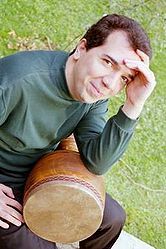- Tonbak
-
"Tombak" redirects here. For the village in Iran, see Tombak, Iran.
Tombak 
Peyman Nasehpoor with a tonbakPercussion Other names Tonback, donbak, domak, Zarb Classification Percussion Related instruments Daf Musicians Hossein Tehrani, Amir Naser Eftetah, Esmaili, Rajabi Not to be confused with Tombac.The tonbak (also tombak, donbak, dombak; in Persian: تمبک, or تُمبَک ,تنبک ,دمبک ,دنبک) or zarb (ضَرب or ضرب) is a goblet drum from Persia (ancient Iran). It is considered the principal percussion instrument of Persian music. The tonbak is normally positioned diagonally across the torso while the player uses one or more fingers and/or the palm(s) of the hand(s) on the drumhead, often (for a ringing timbre) near the drumhead's edge. Sometimes tonbak players wear metal finger rings for an extra-percussive "click" on the drum's shell. Tonbak virtuosi perform solos lasting ten minutes or more.
Description
The Tonbak is a single-headed goblet drum about 43 cm in height with a 28 cm diameter head. Its shell is carved from a single block of (sometimes highly-figured, knotted or marbled) wood, maybe with a carved design or geometric pattern (such as furrows, flutes, diamonds and/or spirals--it is often a costly, heirloom-type or vintage musical instrument). At the bottom the shell is somewhat thicker than at the top for strength (since the drumhead adds to the strength at the top). The shell's wall thickness is approximately 2 cm. The throat is nearly cylindrical and connects the top (body) cavity to the hollow base (the throat itself, the interior of which forms the small opening).
A sheepskin or goatskin head is stretched and secured with glue, tacks or both. The fairly wide top opening permits full bass tone as well as various treble tones (see below). Tonbaks with adjustable tuning have been produced experimentally but the head tension is normally fixed prior to performance with careful attention to the temperature and humidity. The player may heat or cool or dampen or dry the membrane to reach a desired fundamental pitch. The pitch can be raised somewhat during a performance by applying finger pressure but a variety of tapping and clicking timbres reduce overall focus on the drum's pitch. Typically, two or three clearly contrasting timbres (through varying finger placement or clacking of a ring against the drum shell) are played in an antiphonal style.
Goblet-shaped drums are played in different regions of Asia, Eastern Europe and Africa. Although similarities exist among all goblet drums, the techniques for playing the tonbak are different from most other goblet drums. The modern tonbak described in this page is most closely associated with the music of Iran. The tonbak was not considered a virtuoso solo instrument until the pioneering work of Ostad Hossein Tehrani in the 1950s, as well as innovations of Ostad Nasser Farhangfar and others. Modern tonbak players are exponentially expanding the techniques used in playing the instrument.
The most notable present day tonbak maker is Ostad (master) Helmi who still lives and works in Tehran Iran. Instruments in his studio are often intricately carved and laid with ornate Khatam-kari done by masters outside Tehran. His tonbaks often take two shapes, a "teez" (or sharp) hull where emphasis is placed on clear treble tones with an almost fully cynlindrical shell or the opposite bass hull where an exagerated convex round cavity results in a much deeper sound.
Tonbaks in Kashmir
In Kashmir the tonbak is called Tombakh Naar and it is played during marriages. It is made of red clay instead of wood and animal skin on other end for percussion.
See also
- Goblet drum
- Tonbak
- Dunun
- Ashiko
- Djembe
Iranian musical instruments Stringed
(Sāzhāy-e Zehī)BowedPluckedStruckWoodwind
(Sāzhāy-e Bādī)ExposedEnd-blownPercussion
(Sāzhāy-e
Kūbeheyī/Zarbī)AuxiliaryDarāy · Daf · Dohol · Dāvūl · Dāyereh Zangī · Naqāreh · Tonbak (Dombak) · Kūs · Sanj · Dammam · Zarbang UduCategories:- Iranian musical instruments
- Membranophones
- Hand drums
- Albanian musical instruments
- Goblet-shaped drums
Wikimedia Foundation. 2010.



